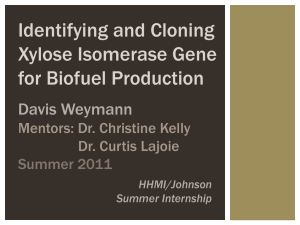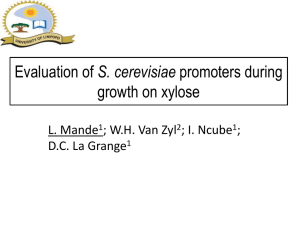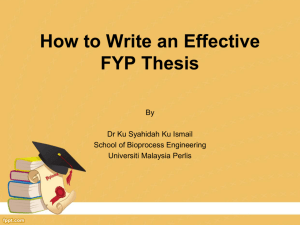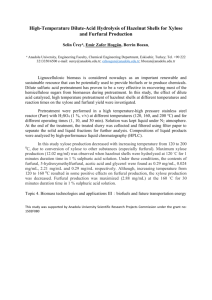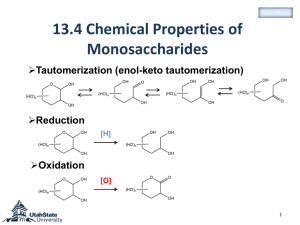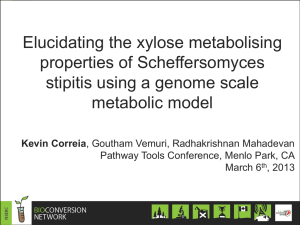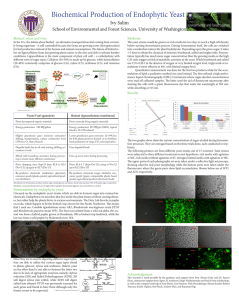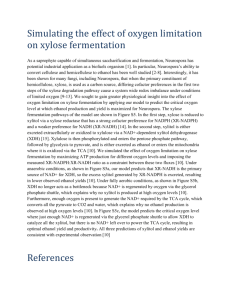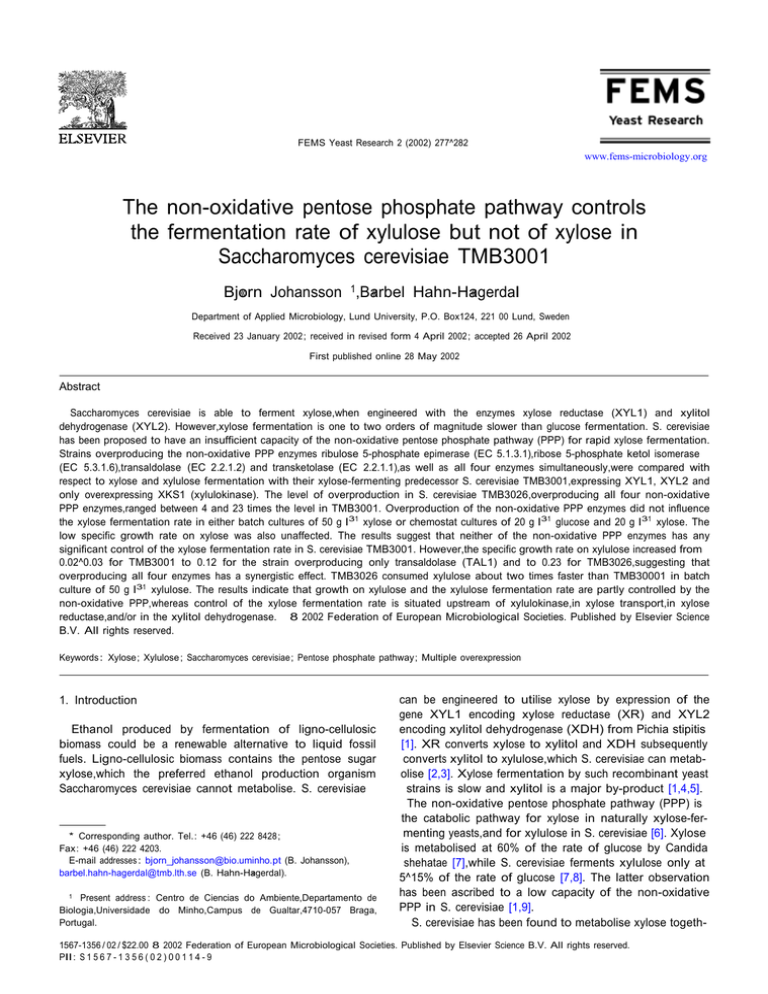
FEMS Yeast Research 2 (2002) 277^282
www.fems-microbiology.org
The non-oxidative pentose phosphate pathway controls
the fermentation rate of xylulose but not of xylose in
Saccharomyces cerevisiae TMB3001
Bjo«rn Johansson 1,Ba«rbel Hahn-Ha«gerdal
Department of Applied Microbiology, Lund University, P.O. Box124, 221 00 Lund, Sweden
Received 23 January 2002 ; received in revised form 4 April 2002 ; accepted 26 April 2002
First published online 28 May 2002
Abstract
Saccharomyces cerevisiae is able to ferment xylose,when engineered with the enzymes xylose reductase (XYL1) and xylitol
dehydrogenase (XYL2). However,xylose fermentation is one to two orders of magnitude slower than glucose fermentation. S. cerevisiae
has been proposed to have an insufficient capacity of the non-oxidative pentose phosphate pathway (PPP) for rapid xylose fermentation.
Strains overproducing the non-oxidative PPP enzymes ribulose 5-phosphate epimerase (EC 5.1.3.1),ribose 5-phosphate ketol isomerase
(EC 5.3.1.6),transaldolase (EC 2.2.1.2) and transketolase (EC 2.2.1.1),as well as all four enzymes simultaneously,were compared with
respect to xylose and xylulose fermentation with their xylose-fermenting predecessor S. cerevisiae TMB3001,expressing XYL1, XYL2 and
only overexpressing XKS1 (xylulokinase). The level of overproduction in S. cerevisiae TMB3026,overproducing all four non-oxidative
PPP enzymes,ranged between 4 and 23 times the level in TMB3001. Overproduction of the non-oxidative PPP enzymes did not influence
the xylose fermentation rate in either batch cultures of 50 g l31 xylose or chemostat cultures of 20 g l31 glucose and 20 g l31 xylose. The
low specific growth rate on xylose was also unaffected. The results suggest that neither of the non-oxidative PPP enzymes has any
significant control of the xylose fermentation rate in S. cerevisiae TMB3001. However,the specific growth rate on xylulose increased from
0.02^0.03 for TMB3001 to 0.12 for the strain overproducing only transaldolase (TAL1) and to 0.23 for TMB3026,suggesting that
overproducing all four enzymes has a synergistic effect. TMB3026 consumed xylulose about two times faster than TMB30001 in batch
culture of 50 g l31 xylulose. The results indicate that growth on xylulose and the xylulose fermentation rate are partly controlled by the
non-oxidative PPP,whereas control of the xylose fermentation rate is situated upstream of xylulokinase,in xylose transport,in xylose
reductase,and/or in the xylitol dehydrogenase. 8 2002 Federation of European Microbiological Societies. Published by Elsevier Science
B.V. All rights reserved.
Keywords : Xylose ; Xylulose ; Saccharomyces cerevisiae ; Pentose phosphate pathway ; Multiple overexpression
1. Introduction
Ethanol produced by fermentation of ligno-cellulosic
biomass could be a renewable alternative to liquid fossil
fuels. Ligno-cellulosic biomass contains the pentose sugar
xylose,which the preferred ethanol production organism
Saccharomyces cerevisiae cannot metabolise. S. cerevisiae
* Corresponding author. Tel. : +46 (46) 222 8428 ;
Fax : +46 (46) 222 4203.
E-mail addresses : bjorn_johansson@bio.uminho.pt (B. Johansson),
barbel.hahn-hagerdal@tmb.lth.se (B. Hahn-Ha«gerdal).
1 Present address : Centro de Ciencias do Ambiente,Departamento de
Biologia,Universidade do Minho,Campus de Gualtar,4710-057 Braga,
Portugal.
can be engineered to utilise xylose by expression of the
gene XYL1 encoding xylose reductase (XR) and XYL2
encoding xylitol dehydrogenase (XDH) from Pichia stipitis
[1]. XR converts xylose to xylitol and XDH subsequently
converts xylitol to xylulose,which S. cerevisiae can metabolise [2,3]. Xylose fermentation by such recombinant yeast
strains is slow and xylitol is a major by-product [1,4,5].
The non-oxidative pentose phosphate pathway (PPP) is
the catabolic pathway for xylose in naturally xylose-fermenting yeasts,and for xylulose in S. cerevisiae [6]. Xylose
is metabolised at 60% of the rate of glucose by Candida
shehatae [7],while S. cerevisiae ferments xylulose only at
5^15% of the rate of glucose [7,8]. The latter observation
has been ascribed to a low capacity of the non-oxidative
PPP in S. cerevisiae [1,9].
S. cerevisiae has been found to metabolise xylose togeth-
1567-1356 / 02 / $22.00 8 2002 Federation of European Microbiological Societies. Published by Elsevier Science B.V. All rights reserved.
PII : S 1 5 6 7 - 1 3 5 6 ( 0 2 ) 0 0 1 1 4 - 9
278
B. Johansson, B. Hahn-Ha«gerdal / FEMS Yeast Research 2 (2002) 277^282
er with ribose,but neither of the sugars alone [10,11].
Xylose and ribose co-metabolism would by-pass the nonoxidative PPP enzyme ribulose 5-phosphate isomerase
(RPE). Flux modelling has shown that the £ux through
the reaction catalysed by RPE is very low in anaerobic
xylose fermenting S. cerevisiae TMB3001 [12]. The nonoxidative PPP intermediate sedoheptulose 7-phosphate accumulates both in xylose-fermenting [1] and in xylulosefermenting [13] S. cerevisiae,suggesting insu⁄cient transaldolase activity. Overexpression of transaldolase leads to
faster aerobic growth on xylose [9],but not to faster xylose
fermentation.
Engineering of single genes to increase metabolic £ux
has generally not been successful. The theory of metabolic
control analysis [14,15] suggests that overproduction of
individual metabolic enzymes will not produce large increases in £ux unless the control coe⁄cient is larger than
0.6 [16]. Therefore simultaneous alteration of multiple
genes would be necessary to achieve increased metabolic
£ux [16,17].
Overproduction of single enzymes in glycolysis does not
improve the rate of glucose fermentation in S. cerevisiae
[18]. However,simultaneous overproduction of seven glycolytic enzymes [19] increases the fermentative capacity
under certain conditions [20]. Tryptophan biosynthesis
may also be enhanced by multiple overproduction of ¢ve
enzymes,where overproduction of the single enzymes has
little e¡ect [21].
The S. cerevisiae genes RPE1, RKI1, TAL1 and TKL1
encode the non-oxidative PPP enzymes ribulose 5-phosphate epimerase (RPE),ribose 5-phosphate isomerase
(RKI),transaldolase (TAL) and transketolase (TKL),respectively. These enzymes carry out the conversion of xylulose 5-phosphate to glyceraldehydes 3-phosphate and
fructose 6-phosphate,which are intermediates of glycolysis. In this investigation we explored the e¡ect of single
and simultaneous overexpression of the non-oxidative PPP
genes on xylose and xylulose fermentation by S. cerevisiae
TMB3001 [22]. TMB3001 is a laboratory xylose-fermenting reference strain expressing P. stipitis XYL1 and XYL2
and overexpressing the endogenous xylulokinase gene
(XKS1).
2. Materials and methods
2.1. Strains
The prototrophic S. cerevisiae TMB3001 [22] was used
as the host strain for all genetic constructions and as control strain. TMB3001 is a S. cerevisiae CEN.PK 113-7A
[23] with the XYL1 (XR) and XYL2 (XDH) genes from
P. stipitis and the endogenous XKS1 gene,encoding xylulokinase,stably integrated into the chromosomal HIS3
locus. S. cerevisiae strains TMB3013,TMB3014,
TMB3016,and TMB3023 overexpress the genes RPE1
(4U), TAL1 (24U), TKL1 (17U),and RKI1 (14U),respectively [24] (values in parentheses represent increased
enzyme activity compared with the level in TMB3001).
The S. cerevisiae genes RPE1, RKI1, TAL1 and TKL1
encode the non-oxidative PPP enzymes ribulose 5-phosphate epimerase (EC 5.1.3.1),ribose 5-phosphate ketol
isomerase (EC 5.3.1.6),transaldolase (EC 2.2.1.2) and
transketolase (EC 2.2.1.1),respectively. TMB3026 overexpresses all four genes, RPE1 (4U), TAL1 (23U), TKL1
(17U),and RKI1 (14U),simultaneously [24]. The overexpressing strains were constructed by cloning the respective gene in the vector pB3 PGK behind the strong PGK1
promoter [25]. The constructs were integrated at the locus
of each gene [24].
2.2. Preparation of inoculum and batch fermentation
De¢ned mineral medium [26] was supplied with 20 g l31
glucose for growth of inoculum and 50 g l31 xylose or
xylulose for batch fermentation. Strains were initially
grown in 500-ml ba¥ed shake £asks in 100 ml glucose
medium. Cells were harvested at a dry weight of ca. 3 g
l31 ,well within the exponential phase. The cells were
washed twice in ice-cold water and re-suspended in icecold xylose or xylulose medium,respectively. Xylulose
was produced in-house as previously described [27]. For
each strain two 25-ml £asks with rubber stoppers and 20
ml working volume were inoculated with 5 g l31 cell dry
weight. The £asks were incubated at 30‡C with magnetic
stirring in a water bath. Samples were withdrawn through
a 2-mm hypodermic needle with a syringe and fermentation gases were expelled through a 0.8-mm needle stu¡ed
with ¢breglass cotton.
2.3. Aerobic growth rate measurements
For speci¢c growth rate determination de¢ned mineral
medium [26] was supplied with 10 g l31 glucose,xylulose
or xylose. Cells were prepared as previously described for
preparation of inoculum. Speci¢c growth rates were determined in 7-ml test tubes containing 3 ml medium. Two
independent experiments including three test tubes were
conducted for each strain and each carbon source. The
tubes were inoculated with washed glucose-grown cells
(prepared as described in Section 2.2),supplied with
loosely ¢tted caps and incubated at 30‡C with vigorous
shaking. Growth was monitored as optical density during
6^8 h with direct spectrophotometric measurement at 620
nm.
2.4. Continuous cultivation
Yeast cells were grown for 12 h in 200 ml de¢ned mineral medium [26] containing 50 g l31 glucose,10 mg l31
ergosterol and 0.4 g l31 Tween 80 in a 250-ml ba¥ed
shake £ask. Cells were centrifuged at 5000Ug for 5 min
B. Johansson, B. Hahn-Ha«gerdal / FEMS Yeast Research 2 (2002) 277^282
at 4‡C,and used to inoculate 1.5 l of the same medium to
OD620 0.5 in a Bio£o III fermenter (New Brunswick Scienti¢c,Edison,NJ,USA). Antifoam was added at 0.5%
(v/v) (Dow Corning Antifoam RD Emulsion,BDH Laboratory Supplies,Poole,UK). Continuous cultivation was set
up at dilution rates of 0.06 and 0.12 h31 at 30‡C,pH
5.5 controlled by addition of 5 M NaOH,and a stirring
speed of 200 rpm. The fermenter was sparged with 0.2 l
min31 nitrogen (containing less than 5 ppm O2 ) as measured with a gas mass £ow meter (Bronkhorst,Ruurlo,
The Netherlands).
2.5. Analysis of substrates and products
Fermentation samples were analysed by HPLC. Glucose,xylose,xylitol,succinate,glycerol,acetate and etha- nol
were separated with an Aminex HPX-87H (Bio-Rad,
Hercules,CA,USA) ion exchange column operated at
45‡C,with a mobile phase of 5 mM H2 SO4 at a £ow
rate of 0.6 ml min31 and detected using a refractive index
detector (Shimadzu,Kyoto,Japan). Cell dry weight was
determined by drying to constant weight in a microwave
oven.
3. Results
3.1. Xylose batch fermentation
The xylose consumption rate in oxygen-limited batch
culture was calculated as the amount of xylose (g) consumed after 40^50 h,divided by time (h) and biomass (g)
(Table 1). The xylose consumption rate was almost the
same for all strains,ranging from 0.11 g (g biomass)31
h31 for TMB3014,overexpressing TAL1,to 0.14 g (g biomass)31 h31 for TMB3017,overexpressing RKI1. Production of xylitol,ethanol,acetate,and glycerol did not vary
signi¢cantly between strains (results not shown).
TMB3026,overexpressing all four non-oxidative PPP
279
Table 1
Speci¢c xylose consumption rates (g xylose (g biomass) 31 h31 ) calculated after 40^50 h of duplicate batch cultivation experiments per strain
Strain
Overexpressed gene(s)
Xylose consumption rate
TMB3001
0.13
TMB3013 RPE1
0.13
TMB3017 RKI1
0.14
TMB3014 TAL1
0.11
TMB3016 TKL1
0.12
TMB3026 RPE1, RKI1, TAL1, TKL1
0.12
The values are the average of two batch cultivations,which di¡ered by
less than 10%.
genes,showed an intermediate xylose consumption rate
of 0.12 g (g biomass)31 h31 (Table 1).
3.2. Continuous cultivations with xylose and glucose
Since only small di¡erences in xylose consumption rate
were detected between strains overproducing the non-oxidative PPP enzymes in batch cultivation,TMB3026 was
also compared with TMB3001 in anaerobic chemostat cultivation with 20 g l31 glucose and 20 g l31 xylose in the
feed. Two steady states were obtained with TMB3001 and
TMB3026 at dilution rates of 0.06 h31 and 0.12 h31 (Table
2). The two strains consumed nearly identical amounts of
glucose and xylose. The product formation di¡ered by 2^
10% between strains at the same dilution rate. The expected di¡erence between duplicates is about 5^8% in
our experimental set-up,which makes the di¡erences between the strains insigni¢cant. The di¡erence in ethanol
production is not signi¢cant,since nitrogen sparging of
the fermenter makes this value less stable between duplicate experiments.
3.3. Xylulose batch fermentation
The e¡ect of simultaneous overexpression of the four
genes encoding enzymes of the non-oxidative PPP on xy-
Table 2
Speci¢c consumption rates (negative values) and production rates (positive values) given as g (g biomass)31 h31 of substrates and products at dilution
rates of 0.06 h31 and 0.12 h31 for TMB3001 and TMB3026 (overexpressing RKI1, RPE1, TAL1 and TKL1)
TMB3001
Xylose
Glucose
CO2
Ethanol
Xylitol
Glycerol
Acetate
Succinate
TMB3026
D = 0.06 h31
D = 0.12 h31
D = 0.06 h31
D = 0.12 h31
30.23
30.61
0.29
0.25
0.10
0.07
2.4U1033
1.9U1033
30.29
31.24
0.51
0.47
0.11
0.15
4.2U1033
4.2U1033
30.23
30.63
0.30
0.28
0.10
0.08
n. d.
8.4U1033
30.29
31.19
0.52
0.51
0.11
0.13
n. d.
1.6U1033
The presented values are the average of duplicate samples from two chemostat experiments per strain.
n.d.,not detectable (below 0.5U1033 g (g biomass)31 h31 ).
280
B. Johansson, B. Hahn-Ha«gerdal / FEMS Yeast Research 2 (2002) 277^282
Table 3
Xylulose concentration at di¡erent timepoints during 20-ml batch fermentation of 50 g l31 xylulose and 5 g l31 biomass with TMB3001 and
TMB3026
Strain
TMB3001
TMB3026
Xylulose concentration in fermenter (g l 31 )
0h
8h
45 h
56 h
68 h
57
54
47
30
37
5
32
2
24
0.4
The presented values are the average of two independent fermentation
experiments with less than 10% di¡erence.
lulose metabolism was also investigated. Xylulose is naturally metabolised by S. cerevisiae [2,3]. Table 3 shows the
time course of xylulose consumption in oxygen-limited
batch cultures of 50 g l31 xylulose with TMB3001 and
TMB3026. TMB3026 consumed xylulose considerably
faster with a ¢nal xylulose concentration of 0.4 g l31 while
TMB3001 left 24 g l31 at the end of the fermentation
(Table 3). Xylulose consumption rates in oxygen-limited
batch culture were calculated after 45 h in the same way as
for xylose fermentation rates. TMB3001 consumed 0.09 g
(g biomass)31 h31 while TMB3026 consumed xylulose
about two times faster (0.22 g (g biomass)31 h31 , Table
4). The result shows that one or more of the non-oxidative
PPP enzymes control the xylulose fermentation rate.
TMB3026 gave slightly higher ethanol yield and nine times
higher xylitol yield than TMB3001,while the glycerol yield
was ¢ve times higher in TMB3001 than in TMB3026 (Table 4). The acetate yield was similar in both strains.
3.4. Aerobic growth rates on di¡erent carbon sources
Maximum speci¢c growth rates on di¡erent carbon
sources were determined (Table 5) to identify physiological
di¡erences resulting from non-oxidative PPP enzyme overproduction. The speci¢c growth rates of the various
strains were similar with glucose (0.28^0.31 h31 ) and xylose (0^0.03 h31 ) as carbon sources (Table 5). The growth
rate with xylulose was in the range of 0.01^0.03 h31 for
TMB3001 and strains individually overproducing RPE,
RKI and TKL (Table 5). These values correspond well
to literature data [2,28]. TMB3014,overexpressing
TAL1,and TMB3026,overexpressing all four non-oxidative PPP genes,grew at a rate of 0.12 h31 and 0.23 h31 ,
respectively.
4. Discussion
In this investigation xylose and xylulose metabolism,
respectively,were compared in two recombinant xylosefermenting strains of S. cerevisiae. TMB3001 expresses a
xylose-utilising pathway comprising XR,XDH and XK,
while TMB3026 in addition overexpresses the four nonoxidative PPP enzymes RPE,RKI,TAL and TKL. The
aim of the investigation was to assess the control of the
non-oxidative PPP on the rates of xylose utilisation and
xylose fermentation. TMB3026 did not show a signi¢cantly higher xylose fermentation rate compared to the
control strain TMB3001 in either chemostat or batch culture. Thus,the non-oxidative PPP did not have any signi¢cant control of the xylose fermentation rate in
TMB3001. On the other hand,TMB3026 fermented xylulose twice as fast as TMB3001,suggesting that the nonoxidative PPP exerts signi¢cant control on xylulose metabolism. During xylose metabolism this control is probably
concealed because other metabolic pathway steps constitute higher degrees of control. After transport across the
plasma membrane xylose is metabolised to xylitol by XR,
which is further metabolised to xylulose by XDH. Subsequent metabolic steps are shared for xylose and xylulose,
indicating that other steps such as xylose transport,XR,
and/or XDH are controlling the xylose consumption rate
to such an extent that control by the non-oxidative PPP is
not detectable during xylose fermentation.
Control of the xylose fermentation rate may also be
exercised by the supply of NAD(P)H for XR and/or
NADþ for XDH. A prime control point in xylose fermentation would be the oxidative PPP,since this pathway is
the principal NADPH-generating pathway in the cell
[29,30]. We have recently demonstrated that the xylose
consumption rate drastically decreases with a non-functional oxidative PPP [31].
The increased xylitol yield in TMB3026 is probably due
to NADH-dependent xylitol formation from xylulose by
xylitol dehydrogenase,since the equilibrium favours xylitol production [32]. The NADH consumption rate due to
combined glycerol and xylitol production in TMB3026
and TMB3001 was similar,1.24 and 1.35 mmol (g biomass)31 h31 ,respectively (calculated from Table 4). This
suggests that TMB3026 maintains its NADH co-factor
balance during xylulose fermentation by secreting xylitol
rather than glycerol.
Table 4
Xylulose consumption rate and ethanol,xylitol,acetate and glycerol yields after 45 h
Strain
TMB3001
TMB3026
Xylulose consumption rate (g (g biomass)31 h31 )
0.09
0.22
Yield (g (g consumed xylulose)31 )
Ethanol
Xylitol
Acetate
Glycerol
0.33
0.39
0.02
0.17
0.03
0.02
0.10
0.02
The presented values are the average of two independent fermentation experiments with less than 10% di¡erence.
B. Johansson, B. Hahn-Ha«gerdal / FEMS Yeast Research 2 (2002) 277^282
281
Table 5
Aerobic speci¢c growth rates in de¢ned mineral medium with 10 g l31 glucose,xylose or xylulose as carbon source
Strain
TMB3001
TMB3013
TMB3017
TMB3014
TMB3016
TMB3026
Overexpressed gene(s)
Wmax (h31 ) (S.D.,%)
RPE1
RKI1
TAL1
TKL1
RPE1, RKI1, TAL1, TKL1
Glucose
0.32 (1)
0.31 (3)
0.30 (4)
0.28 (2)
0.28 (2)
0.29 (6)
Xylose
0.01 (43)
n.d. (^)
0.02 (28)
0.01 (20)
n.d. (^)
0.03 (27)
Xylulose
0.03 (38)
0.01 (79)
0.02 (36)
0.12 (6)
0.02 (42)
0.23 (3)
Values are the average of two experiments performed in triplicate. The relative standard deviation is given as percentage of the average speci¢c growth
rate.
n.d.,not detectable (below 0.005 h31 ).
The maximum speci¢c growth rate on xylulose increased
upon TAL overproduction,supporting the hypothesis that
TAL activity limits pentose metabolism in S. cerevisiae
[1,9,13]. Overproduction of TAL increased the aerobic
growth on solid xylose media of a XYL1/XYL2-expressing
strain [9] as measured by visual inspection of cell mass
after 3 days. TAL overproduction did not improve the
growth rate in liquid xylose medium (Table 5),possibly
because growth was measured during a shorter time. Also,
oxygen could be less available in liquid than on solid culture. Oxygen is known to increase the growth rate in xylose medium [33,34].
Overproduction of RPE had no e¡ect on either xylose
or xylulose consumption rate,suggesting that the relatively
e⁄cient xylose and ribose co-metabolism [10,11] and the
£ux modelling results [12] cannot be ascribed to insu⁄cient RPE activity.
Overexpression of TKL1 has been reported to inhibit
growth on fermentative carbon sources [35]. Similarly,expression of the P. stipitis TKT1 gene encoding transketolase in S. cerevisiae expressing XYL1 and XYL2 resulted in
increased generation times of aerobic xylose growth [36].
None of the two strains overexpressing TKL1 reported
here,TMB3016 and TMB3026,had impaired xylose metabolism (Table 1),neither did TKL1 overexpression impair growth of a XYL1/XYL2-expressing S. cerevisiae [9].
In addition to di¡erences in host strain properties and
cultivation conditions,these discrepancies could be due to
a lower speci¢c TKL activity in TMB3016 and
TMB3026 (2.7^2.8 U (mg protein)31 [24] and 0.92^0.97
U (mg protein)31 [9]),compared with 6.7 U (mg
protein)31 reported by Metzger and Hollenberg [36].
The speci¢c growth rate on xylulose increased four
times by overproducing TAL,but did not change by overproduction of RPE,RKI or TKL. Yet,the growth rate on
xylulose increased up to eight times the reference level
when all four genes were overproduced. This synergistic
e¡ect suggests that overproduction of more than one enzyme is necessary in order to maximise strain performance
and that the important enzymes cannot always be identi¢ed by the e¡ect of overproducing a single enzyme
[16,17,20,21].
Once the initial xylose metabolism has been improved,it
is conceivable that higher xylose £uxes could be obtained
by additional overproduction of the non-oxidative PPP
enzymes. The integrative vector system by which
TMB3026 was created [24] facilitates virtually unlimited
rounds of genetic engineering so any future genetic modi¢cations are easily carried out.
Acknowledgements
This work was ¢nancially supported by The Swedish
National Energy Administration and The Nordic Energy
Research Programme.
References
[1] Ko«tter,P. and Ciriacy,M. (1993) Xylose fermentation by Saccharomyces cerevisiae. Appl. Microbiol. Biotechnol. 38,776^783.
[2] Wang,P.Y. and Schneider,H. (1980) Growth of yeasts on D-xylulose. Can. J. Microbiol. 26,1165^1168.
[3] Wang,P.Y.,Shopsis,C. and Schneider,H. (1980) Fermentation of a
pentose by yeasts. Biochem. Biophys. Res. Commun. 94,248^
254.
[4] Tantirungkij,M.,Nakashima,N.,Seki,T. and Yoshida,T. (1993)
Construction of xylose-assimilating Saccharomyces cerevisiae. J. Ferment. Bioeng. 75,83^88.
[5] Walfridsson,M.,Anderlund,M.,Bao,X. and Hahn-Ha«gerdal,B.
(1997) Expression of di¡erent levels of enzymes from the Pichia stipitis XYL1 and XYL2 genes in Saccharomyces cerevisiae and its e¡ects
on product formation during xylose utilisation. Appl. Microbiol. Biotechnol. 48,218^224.
[6] Ligthelm,M.E.,Prior,B.A.,du Preez,J.C. and Brandt,V. (1988) An
investigation of D-{1-13 C} xylose metabolism in Pichia stipitis under
aerobic and anaerobic conditions. Appl. Microbiol. Biotechnol. 28,
293^296.
[7] Yu,S.,Jeppsson,H. and Hahn-Ha« gerdal,B. (1995) Xylulose fermentation by Saccharomyces cerevisiae and xylose-fermenting yeast
strains. Appl. Microbiol. Biotechnol. 44,314^320.
[8] Jeppsson,H.,Yu,S. and Hahn-Ha« gerdal,B. (1996) Xylulose and
glucose fermentation by Saccharomyces cerevisiae in chemostat culture. Appl. Environ. Microbiol. 62,1705^1709.
[9] Walfridsson,M.,Hallborn,J.,Penttila« ,M.,Kera« nen,S. and Hahn- Ha«
gerdal,B. (1995) Xylose-metabolizing Saccharomyces cerevisiae
strains overexpressing the TKL1 and TAL1 genes encoding the pen-
282
[11]
[12]
[13]
[14]
[15]
[16]
[17]
[18]
[19]
[20]
[21]
[22]
[23]
B. Johansson, B. Hahn-Ha«gerdal / FEMS Yeast Research 2 (2002) 277^282
tose phosphate pathway enzymes transketolase and transaldolase.
Appl. Environ. Microbiol. 61,4184^4190.
[10] van Zyl,C.,Prior,B.A.,Kilian,S.G. and Kock,J.L. (1989) D-Xylose
utilization by Saccharomyces cerevisiae. J. Gen. Microbiol. 135,2791^
2798.
van Zyl,C.,Prior,B.A.,Kilian,S.G. and Brandt,E.V. (1993) Role of Dribose as a co-metabolite in D-xylose metabolism by Saccharomyces
cerevisiae. Appl. Environ. Microbiol. 59,1487^1494.
Wahlbom,C.F.,Eliasson,A. and Hahn-Ha« gerdal,B. (2001) Intracellular £uxes in a recombinant xylose-utilizing Saccharomyces cerevisiae cultivated anaerobically at di¡erent dilution rates and feed
concentrations. Biotechnol. Bioeng. 72,289^296.
Senac,T. and Hahn-Ha« gerdal,B. (1990) Intermediary metabolite
concentrations in xylulose- and glucose-fermenting Saccharomyces
cerevisiae cells. Appl. Environ. Microbiol. 56,120^126.
Kacser,H. and Burns,J.A. (1973) The control of £ux. Symp. Soc.
Exp. Biol. 27,65^104.
Heinrich,R. and Rapoport,T.A. (1974) A linear steady-state treatment of enzymatic chains : General properties,control and e¡ectorstrength. Eur. J. Biochem. 42,89^95.
Fell,D.A. and Thomas,S. (1995) Physiological control of metabolic
£ux : The requirement for multi-site modulation. Biochem. J. 311,35^
39.
Kacser,H. and Acerenza,L. (1993) A universal method for achieving
increases in metabolite production. Eur. J. Biochem. 216,361^367.
Schaa¡,I.,Heinisch,J. and Zimmermann,F.K. (1989) Overproduc- tion
of glycolytic enzymes in yeast. Yeast 5,285^290.
Hauf,J.,Zimmermann,F.K. and Mu« ller,S. (2000) Simultaneous
genomic overexpression of seven glycolytic enzymes in the yeast Saccharomyces cerevisiae. Enzyme Microb. Technol. 26,688^698.
Smits,H.P.,Hauf,J.,Mu« ller,S.,Hobley,T.J.,Zimmermann,F.K., Hahn-Ha«
gerdal,B.,Nielsen,J. and Olsson,L. (2000) Simultaneous overexpression
of enzymes of the lower part of glycolysis can enhance the fermentative
capacity of Saccharomyces cerevisiae. Yeast 16,
1325^1334.
Niederberger,P.,Prasad,R.,Miozzari,G. and Kacser,H. (1992) A
strategy for increasing an in-vivo £ux by genetic manipulations. The
tryptophan system of yeast. Biochem. J. 287,473^479.
Eliasson,A.,Christensson,C.,Wahlbom,C.F. and Hahn-Ha« gerdal, B.
(2000) Anaerobic xylose fermentation by recombinant Saccharomyces cerevisiae carrying XYL1, XYL2,and XKS1 in mineral medium chemostat cultures. Appl. Environ. Microbiol. 66,3381^3386.
van Dijken,J.P.,Bauer,J.,Brambilla,L.,Duboc,P.,Francois,J.M.,
Gancedo,C.,Giuseppin,M.L.,Heijnen,J.J.,Hoare,M.,Lange,
H.C.,Madden,E.A.,Niederberger,P.,Nielsen,J.,Parrou,J.L.,Petit,
T.,Porro,D.,Reuss,M.,van Riel,N.,Rizzi,M.,Steensma,H.Y.,
Verrips,C.T.,Vindelov,J. and Pronk,J.T. (2000) An interlaboratory
comparison of physiological and genetic properties of four Saccharomyces cerevisiae strains. Enzyme Microb. Technol. 26,706^714.
[24] Johansson,B. and Hahn-Ha« gerdal,B. (2002) Overproduction of pentose phosphate pathway enzymes using a new CRE/loxP expression
vector for repeated genomic integration in Saccharomyces cerevisiae.
Yeast 19,225^231.
[25] Mellor,J.,Dobson,M.J.,Roberts,N.A.,Tuite,M.F.,Emtage,J.S.,
White,S.,Lowe,P.A.,Patel,T.,Kingsman,A.J. and Kingsman, S.M.
(1983) E⁄cient synthesis of enzymatically active calf chymosin in
Saccharomyces cerevisiae. Gene 24,1^14.
[26] Verduyn,C.,Postma,E.,Sche¡ers,W.A. and Van Dijken,J.P. (1992)
E¡ect of benzoic acid on metabolic £uxes in yeasts : A continuousculture study on the regulation of respiration and alcoholic fermentation. Yeast 8,501^517.
[27] Olsson,L.,Linde¤n,T. and Hahn-Ha« gerdal,B. (1994) A rapid chromatographic method for the production of preparative amounts of
xylulose. Enzyme Microb. Technol. 16,388^394.
[28] Richard,P.,Toivari,M.H. and Penttila« ,M. (2000) The role of xylulokinase in Saccharomyces cerevisiae xylulose catabolism. FEMS Microbiol. Lett. 190,39^43.
[29] Bruinenberg,P.M.,van Dijken,J.P. and Sche¡ers,W.A. (1983) An
enzymic analysis of NADPH production and consumption in Candida utilis. J. Gen. Microbiol. 129,965^971.
[30] Nogae,I. and Johnston,M. (1990) Isolation and characterization of
the ZWF1 gene of Saccharomyces cerevisiae,encoding glucose-6phosphate dehydrogenase. Gene 96,161^169.
[31] Jeppsson,M.,Johansson,B.,Hahn-Ha« gerdal,B. and Gorwa-Grauslund,M.F. (2002) Reduced oxidative pentose phosphate pathway £ux
in recombinant xylose-utilizing Saccharomyces cerevisiae strains improves the ethanol yield from xylose. Appl. Environ. Microbiol. 68,
1604^1609.
[32] Rizzi,M.,Harwart,K.,Erlemann,P.,Bui-Thanh,N.-A. and Dell- weg,H.
(1989) Puri¢cation and properties of the NADþ -xylitol-dehydrogenase from the yeast Pichia stipitis. J. Ferment. Bioeng. 67,
20^24.
[33] Skoog,K. and Hahn-Ha«gerdal,B. (1990) E¡ect of oxygenation on
xylose fermentation by Picha stipitis. Appl. Environ. Microbiol. 56,
3389^3394.
[34] Toivari,M.H.,Aristidou,A.,Ruohonen,L. and Penttila« ,M. (2001)
Conversion of xylose to ethanol by recombinant Saccharomyces cerevisiae : Importance of xylulokinase (XKS1) and oxygen availability.
Metab. Eng. 3,236^249.
[35] Sundstro« m,M.,Lindqvist,Y.,Schneider,G.,Hellman,U. and Ronne,H.
(1993) Yeast TKL1 gene encodes a transketolase that is required for
e⁄cient glycolysis and biosynthesis of aromatic amino acids. J.
Biol. Chem. 268,24346^24352.
[36] Metzger,M.H. and Hollenberg,C.P. (1994) Isolation and characterization of the Pichia stipitis transketolase gene and expression in a
xylose-utilising Saccharomyces cerevisiae transformant. Appl. Microbiol. Biotechnol. 42,319^325.

